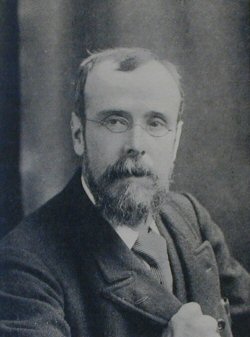 JAMES
PATON
JAMES
PATONTHE Superintendent of Glasgow Corporation art Galleries was born at Auchtergaven, Perthshire, 15th April, 1843. On his own side he counts kin with Robert Nicoll, the poet, and through his wife with Robert Burns himself. He received his education at the school of his native parish, a private school in Perth, and Edinburgh University, and he served an apprenticeship to law in a writer's office in Perth. Then, going to Edinburgh, he accepted a temporary situation in the Industrial Museum in 1861. There he remained for fifteen years. In 1876 he came to Glasgow to take charge of the Kelvingrove Museum, and in the following year he was made Curator also of the Corporation Galleries in Sauchiehall Street.
At that time the galleries were altogether neglected, and it was only by Mr. Paton's exertions that Glasgow became aware that it possessed the most rare and valuable collection of pictures in the kingdom, outside of London. Since his appointment he has seen many developments of his office. Camphill Art Gallery, and the branch museum in the People's Palace at the Green have been added to his charge, and in 1902, on the Corporation taking over the magnificent new Art Galleries at Kelvingrove, the contents were moved thither of the city's art collection in Sauchiehall Street, and the Natural History and Archaeological Collection formerly in Kelvingrove House. Where at first he had a single assistant he now has a staff of sixty, and the visitors to the various collections under his charge number in ordinary times some twenty thousand a week.
In connection with the organisation and opening of Museums, Mr. Paton can claim an experience altogether unique. In Edinburgh he took an active part in the installation in 1863 of the collections of what was first called the Industrial Museum of Scotland in the range of houses in Argyle Square, where the institution first was opened to the public. When, in 1866, the first instalment of the Edinburgh Museum of Science and Art was opened he was equally concerned in the transfer and re-arrangement of the collections; and the second extension and remodelling of that institution was just completed before Mr. Paton resigned his office under the Science and art Department. His first duty on coming to Glasgow was the collecting and arranging of an exhibition of local industries in the newly-finished wing of Kelvingrove Museum in connection with the meeting of the British Association in 1876. At the close of that meeting he had to fit out the hall as a technological museum, which character it retained till the early part of 1900. Within a year the Corporation Galleries of Art came under his care, and that institution had to be rehabilitated. Thereafter exhibitions of special and local character, too numerous to mention, were organised by him, partly in connection with the Corporation Galleries, and partly in various districts throughout the city. It was on his instigation that the Corporation, through the Museums and Galleries Committee, took up the question of holding in 1888 an International Exhibition in Glasgow, and the secretarial duties connected with that undertaking in its early stages fell upon him. The wonderful collection of historical and personal relics in the Bishop's Castle, the most valuable feature of the Exhibition, was made and arranged under his supervision. Later he had in succession the formation and establishment of the Camphill Gallery and Museum in Queen's Park and the Green Branch (People's Palace) on Glasgow Green. His further experience was connected with the organisation of the Fine Art and Scottish History Section of the International Exhibition of 1901, which first occupied the permanent building erected as the Art Gallery and Museum of Glasgow. For that section he acted as Honorary Secretary, again in this concerning himself personally with the Scottish History and Antiquarian Section. Finally he has crowned his labours with the installation of the Art and Science Collections of the city within the Palace erected for their accommodation. These, judged from the number of visitors, form the most popular municipal museum in the world.
In connection with his work Mr. Paton has frequently visited most of the great art galleries of Europe, and he is a recognised expert, especially upon the art of the old masters. For years, too, he delivered weekly lectures during winter in the Corporation Galleries on art subjects, drawing large audiences. Among his many writings, he was an extensive contributor to the great encyclopaedias - the Britannica, Chambers's, and the Globe; he collaborated with Sir James Bell, Bart., in the volume on "Glasgow, its Municipal Organisation and Administration;" he was largely the author of "Scottish National Memorials;" for the "Book of Glasgow Cathedral" he wrote the valuable chapter on the ancient connection of the Bishopric and the Municipality; and he was the editor of the two memorial volumes on the Art and Historical Section of the Glasgow International Exhibition of 1901. In 1896 he was elected President of the Museums Association of the United Kingdom.
Mr. Paton married in 1866, Mary, daughter of Mr. James Kesson, Fordoun, Kincardineshire.